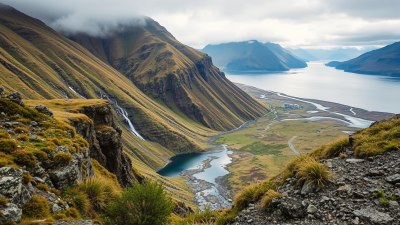How to Survive a Mountain Trip Without Losing the Trail
Essential tips for navigating and surviving a mountain trip without losing your trail.

Embarking on a mountain trip can be both an exhilarating and daunting experience. The beauty of nature is matched only by the challenge of navigating through the wilderness. Losing the trail can lead to disorientation, increased risk of accidents, and heightened anxiety. Therefore, understanding how to stay on the path and effectively handle your journey is critical. This article aims to provide comprehensive strategies for surviving a mountain trip without losing your way.
Preparation is Key
One of the most important aspects of any outdoor adventure is preparation. Knowing what to expect before you set out can make a huge difference in your overall experience. Begin by researching your destination. Familiarize yourself with the terrain, weather conditions, and potential hazards. Use topographic maps and guidebooks to gain insights into the area. Here are essential points to consider:
1. Study Maps & Trails: Obtain detailed maps of the area you intend to hike. Pay attention to trail markers, elevation changes, and important landmarks. Identify various routes and the distance you can cover in a day.
2. Use Technology: Smartphones equipped with GPS applications can be lifesavers. Consider downloading offline maps that work without cell service, allowing you to track your route effectively.
3. Weather Check: Always check the weather forecast before your trip. Mountain weather can change drastically and unexpectedly, so be prepared for various conditions and pack accordingly.
Essential Gear for Navigation
The right gear can significantly aid in navigation and safety. Here’s a list of essential equipment to bring on your mountain adventure:
1. Topographic Maps: A physical map can work without batteries and technology. Ensure you know how to read it well.
2. Compass: A compass is a traditional yet effective tool for navigation. Familiarize yourself with its operation and practice using it prior to your trip.
3. GPS Device/Smartphone: Carry a portable GPS device or a smartphone loaded with navigation apps. Make sure to have a portable charger as a backup.
4. First Aid Kit: In case of injuries or accidents, a well-stocked first aid kit is indispensable.
5. Extra Food and Water: Always pack more sustenance and hydration than you think you'll need. Dehydration and hunger can impair judgment and awareness.
Staying on Course
Now that you are adequately prepared, let’s discuss strategies for staying on the trail and recognizing potential challenges along the way:
1. Track Your Trail: As you hike, keep an eye on the distinctions between trails. Pay attention to markers, signs, and the trail’s general appearance. Mark your path using rocks or branches to avoid heading back the way you came unintentionally.
2. Familiar Landmarks: Use significant natural features like rivers, mountains, or unique trees as reference points. This can help in verifying that you’re on the right track.
3. Regular Check-ins: Frequently check your maps and GPS to ensure you’re on the right path. Set milestones to help in this effort, such as reaching a specific landmark or distance every half hour.
4. Group Communication: If hiking with a group, regularly communicate about your location and how everyone feels regarding the route. This can help you stick together and avoid going off-trail.
Identifying Trail Blazes
Trail blazes provide visual guidance and are vital for navigating mountain trails. Understanding different types of blazes can enhance your navigation skills:
1. Colors: Different trails often have specific colors for blazes. Familiarize yourself with the trail colors before your trip.
2. Shapes & Symbols: Some trail systems utilize specific shapes or symbols painted on trees or rocks. Recognizing these can help confirm you’re on the right path.
What to Do if You Get Lost
Despite your best efforts, there may still come a time when you realize you’ve lost your way. Panic can set in quickly, but staying calm is crucial. Here’s how to handle the situation:
1. Stop & Assess: The first step is to stop moving. Sit down, breathe, and assess your surroundings. Panic can lead to poor decision-making.
2. Retrace Your Steps: If you feel confident about how far you’ve traveled, try retracing your path to find recognizable landmarks.
3. Use Your Navigational Tools: Pull out your map, compass, or GPS. Fix your position and determine the next steps. If you’re unsure, heading downhill typically leads to better paths.
4. Stay Put if Necessary: If you’re completely disoriented, it may be safer to stay in one place and wait for help rather than wandering aimlessly.
Emergency Preparation
In the event things go south, preparation can make all the difference. Make sure to have an emergency plan:
1. Inform Someone: Always let someone know your planned route and expected return time. This will help if a search party needs to be organized.
2. Signal for Help: If you believe you are lost and need assistance, use a whistle, reflective mirror, or even a signal fire (if safe to do so) to signal for help.
3. Know Basic Survival Techniques: Familiarize yourself with basic survival skills, such as building a shelter, finding water, and food sources.
Understanding Nature’s Signals
The natural environment can provide signals that help in navigation:
1. Sun Position: The sun rises in the east and sets in the west. If it’s noon, the sun will be roughly in the southern sky in the northern hemisphere.
2. Vegetation Patterns: In some regions, tree growth or moss can indicate north, as they tend to grow denser on the northern side in certain climates.
Staying Hydrated and Energized
In the wilderness, maintaining hydration and energy is vital for clear thinking and overall performance:
1. Water Sources: Plan your route considering available water sources. Carry a water filter or purification tablets to ensure safe drinking water.
2. Energy-Rich Snacks: Bring along high-energy snacks such as nuts, dried fruit, or energy bars. Eating small amounts can help maintain energy levels without slowing you down.
The Importance of Mindfulness
Finally, cultivating mindfulness during your hike helps to enhance awareness and enjoyment of the experience:
1. Full Attention: Be present in the moment. Notice sounds, scents, and sights around you. This helps maintain awareness of your surroundings.
2. Reflective Practice: Take a moment to appreciate your environment and the effort you’ve put into your trip. This not only enhances your experience but also helps keep your mental state positive.
Conclusion
Surviving a mountain trip without losing the trail involves preparation, awareness, and effective navigation skills. By taking the necessary precautions and familiarizing yourself with your surroundings, you can enjoy the beauty of the mountains while ensuring your safety. The wilderness is a magnificent place full of adventure; learning to navigate it effectively will create memories that last a lifetime. Remember to respect nature and leave no trace, ensuring that future generations can also enjoy the great outdoors.











